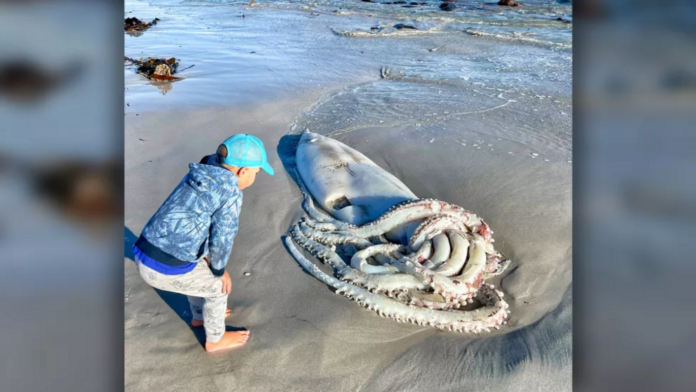Giant squid that washed up on a South African beach was ‘incredible to see’
Giant squids live in the deep ocean, and rarely wash up on beaches.
The massive sea creature measured nearly a dozen feet long.
On April 30, beachgoers in Kommetjie, South Africa encountered a rare sight: a giant squid carcass glistening on the sand at Long Beach.
“It was incredible to see,” Alison Paulus, a Cape Town resident and founder of the wildlife conservation organization Volunteer and Explore, told Live Science in an email. “The body was around 2.2 meters [7.2 feet] alone, then with the tentacles and arms I’m sure it would have stretched to 3.5 meters [11.5 feet].”
Giant squids are among the most elusive animals on the planet. They live at ocean depths between 1,000 to 3,000 feet (300 to 1,000 m) and only rarely rise to the sea surface. For centuries, the only information scientists had about these creatures came from studying beached carcasses or remains found in the bellies of sperm whales — the first photos of a live giant squid weren’t captured until 2004, according to National Geographic.
Spotting a giant squid on a South African beach is rare, though not unheard of. A beautifully preserved baby giant squid washed up near Cape Town in 2020, the Washington Post reported. Another adult specimen that washed ashore in the same area in 1992 was just over 30 feet (9 m) long, Devon Bowen, a digital manager at Two Oceans Aquarium in Cape Town, told the South African news site Independent Online (IOL).
This squid beached at night after sustaining injuries, possibly from an encounter with a commercial boat or fishing vessel. “We could see a long gash above its tentacles which we presume was from a boat propeller,” Paulus said. Investigation by wildlife professionals revealed that the animal was a female. “I would say that she was most likely struck by a ship while she was at the sea surface,” Jon Friedman, a wildlife officer from the Cape of Good Hope Society for the Prevention of Cruelty to Animals (SPCA), told IOL.
Friedman estimated that the squid was around two years old when she died. Giant squids can live for up to five years and reach lengths of 43 feet (13 m), though most top out around 36 feet (11 m), according to Smithsonian.
By the time SPCA officials reached the scene, local fishers had already removed the squid’s eyes, beak, and portions of its tentacles. Most of what remained of the carcass was then chopped up by the SPCA and thrown back into the sea, though officials sent some tissue samples off to Cape Town’s Iziko South African Museum for DNA analysis. The museum currently holds the remains of 19 other giant squids, IOL reported.
Paulus was disappointed that the body did not make it back to the museum, but said that her family was thrilled to see the squid while it was still intact. “I have two small sons who are crazy about wildlife, so we went down straight away to see,” she said.
Originally published on Live Science.

